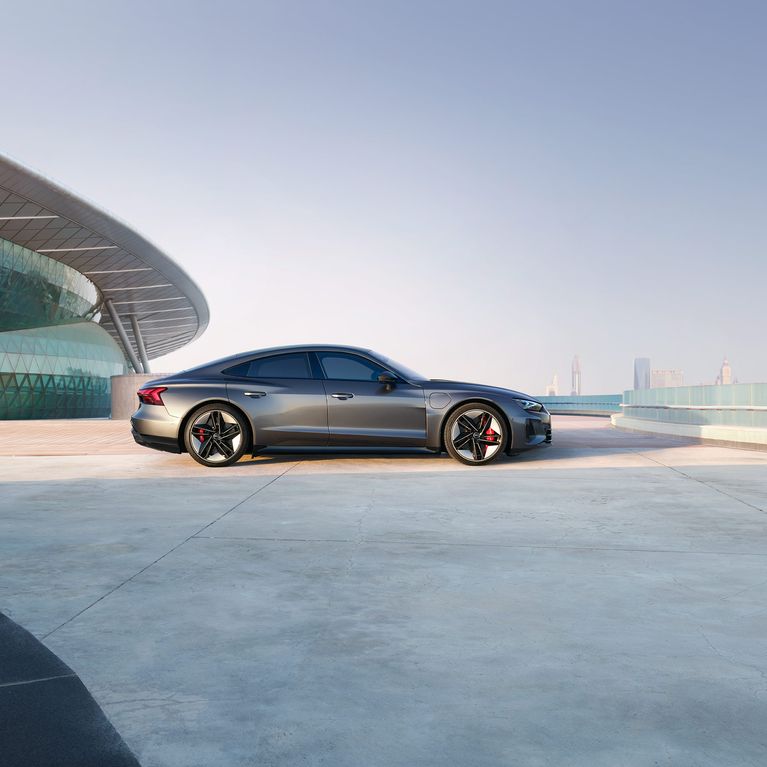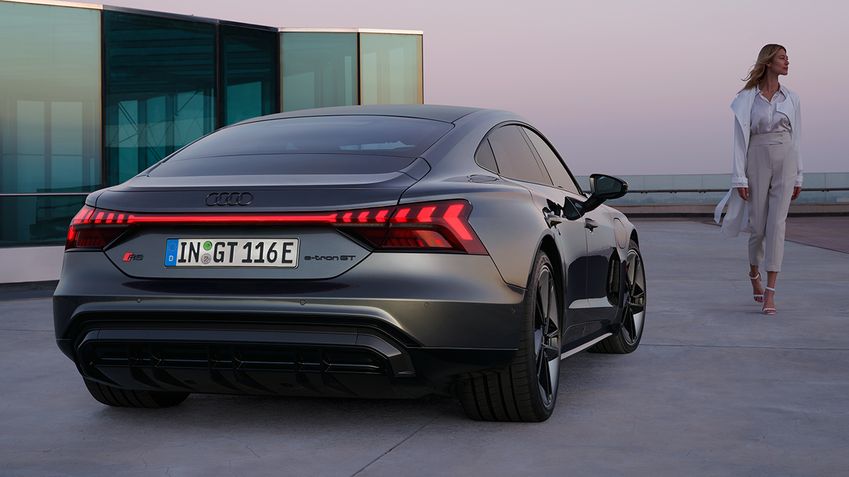
RS e-tron GT
Pure energy and progressive performance

The geometry of acceleration
The sculptural design unites the dynamic proportions of a gran turismo with the unmistakeable characteristics of an Audi RS model.
Electrical consumption combined in kWh/100 km¹: 20.2-19.3 (NEDC); 22.5-20.6 (WLTP); CO₂ emissions combined in g/km¹: 0. Electrical consumption and CO₂ emission figures given in ranges depend on the equipment selected for the vehicle.

Sportiness and exclusivity fuse
The optional carbon roof is made of a carbon-fibre-reinforced polymer. The high-tech material is very stable while also being extremely lightweight.
Electrical consumption combined in kWh/100 km¹: 20.2-19.3 (NEDC); 22.5-20.6 (WLTP); CO₂ emissions combined in g/km¹: 0. Electrical consumption and CO₂ emission figures given in ranges depend on the equipment selected for the vehicle.

Focused on aesthetic driving dynamics
In the Audi RS e-tron GT², everything is focused on the functional center of the interior: the driver’s position.
Electrical consumption combined in kWh/100 km¹: 20.2-19.3 (NEDC); 22.5-20.6 (WLTP); CO₂ emissions combined in g/km¹: 0. Electrical consumption and CO₂ emission figures given in ranges depend on the equipment selected for the vehicle.

Passion creates progress
Manufacturing the electrically powered gran turismo in the Böllinger Höfe, close to Neckarsulm, is where attention to detail meets precision and quality.

Electrifying start
A vehicle with the potential to fascinate is the edition one limited equipment combination for the first customers of the Audi RS e-tron GT².
Electrical consumption combined in kWh/100 km¹: 20.2-19.3 (NEDC); 22.5-20.6 (WLTP); CO₂ emissions combined in g/km¹: 0. Electrical consumption and CO₂ emission figures given in ranges depend on the equipment selected for the vehicle.
Output
kW
Acceleration (0–100 km/h)
s
Charging system
volt
Universal presence
This ambition – to reinterpret a car – is also reflected in the purist design, which is inspired by aerodynamic performance. Progressive luxury provides the impetus to further intensify a driving experience brimming with emotion. Characteristic: RS emblems with the red rhombus.


Precise finish
The boldly sculpted shoulder line and the distinctive rear diffuser give an impression of impressive strength. The gently sloping roofline that extends well into the rear of the Audi RS e-tron GT² expresses the vehicle’s urgency to move forward even while it is stationary.
Electrical consumption combined in kWh/100 km¹: 20.2-19.3 (NEDC); 22.5-20.6 (WLTP); CO₂ emissions combined in g/km¹: 0. Electrical consumption and CO₂ emission figures given in ranges depend on the equipment selected for the vehicle.
Dynamic expression: The RS design packages
The RS design package, red adds striking accents to the vehicle interior through contrasting stitching in express red. The RS design package, grey underscores the design of the vehicle interior through a combination of high-quality interior materials and subtle contrasting stitching in steel grey.

Everything in view
The pared-back cockpit with fully digital 12.3-inch colour display and the centre console are ergonomically oriented to the driver.
Electrical consumption combined in kWh/100 km¹: 20.2-19.3 (NEDC); 22.5-20.6 (WLTP); CO₂ emissions combined in g/km¹: 0. Electrical consumption and CO₂ emission figures given in ranges depend on the equipment selected for the vehicle.

Rear row of seats
The distinctive outer rear seats with an additional, central seat option emphasise the sporty character.
Electrical consumption combined in kWh/100 km¹: 20.2-19.3 (NEDC); 22.5-20.6 (WLTP); CO₂ emissions combined in g/km¹: 0. Electrical consumption and CO₂ emission figures given in ranges depend on the equipment selected for the vehicle.
The formula for progress
The 800-volt lithium-ion battery integrated into the flat underbody, offers extremely high performance – both when charging and when driving. In combination with the recuperation system, it provides a range of up to 472-433 km according to the WLTP measurement procedure.

Fast charging³
The performance of the Audi RS e-tron GT² is also evident during charging: at up to 270 kW at 800-volt charging stations – as standard. It takes approx. 5 minutes to charge enough power for the next 100 km. Around 22.5 minutes will take the battery charge from 5 % back up to approx. 80 %.
Electrical consumption combined in kWh/100 km¹: 20.2-19.3 (NEDC); 22.5-20.6 (WLTP); CO₂ emissions combined in g/km¹: 0. Electrical consumption and CO₂ emission figures given in ranges depend on the equipment selected for the vehicle.
RS in a new dimension
The power delivery that the Audi RS e-tron GT² offers with its fully electric quattro all-wheel drive is impressive. With an electric drive on both the front and rear axles, it can deliver up to 440 kW of power (Electrical consumption combined in kWh / 100 km¹: 20.2-19.3 (NEDC); 22.5-20.6 (WLTP); Combined CO₂ emissions in g / km¹: 0).
Energy for 100 km charged in
min
Battery from 5 % to 80% charged in
min
Range (WLTP)
km
The sound of the RS e-tron GT²
#FutureIsAnAttitude News
The next major milestone on the road to the mobility of the future has been unveiled. Get exclusive information about Audi RS e-tron GT² with #FutureIsAnAttitude News.











